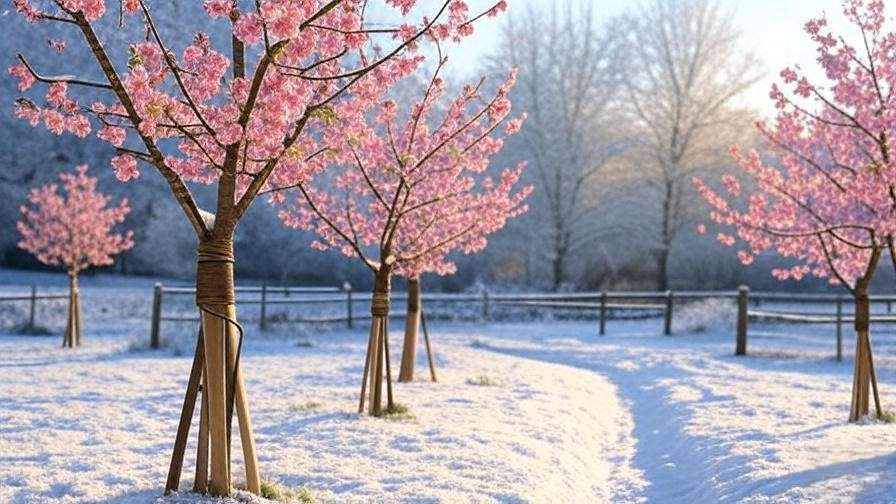Imagine standing in your garden, watching heavy snow blanket your beloved cherry trees, their delicate branches bending under the weight. Your heart sinks as you wonder if they’ll survive the winter. For gardeners and orchard owners, protecting cherry trees from heavy snowfall and ice is a critical task to ensure vibrant spring blooms and bountiful fruit harvests. These iconic trees, cherished for their beauty and bounty, are vulnerable to winter’s wrath. But with the right strategies, you can safeguard them. In this comprehensive guide, we share seven expert-backed tips to protect your cherry trees, drawing on decades of arboricultural experience, insights from certified arborists, and research from trusted sources like university extension programs. Whether you’re a seasoned gardener or a first-time tree owner, this article will equip you with practical, actionable steps to keep your cherry trees thriving through the harshest winters. 🌨️
Why Heavy Snowfall and Ice Are Threats to Cherry Trees ❄️🌨️
Understanding the Risks to Cherry Trees
Cherry trees, with their delicate branches and often brittle wood, face significant risks from heavy snowfall and ice. Snow accumulation can weigh down branches, causing them to snap or split, while ice encasement can lead to structural damage or even trunk failure. According to a study by the USDA, fruit trees like cherries are particularly susceptible to winter damage, with up to 30% of unprotected trees experiencing branch loss in severe storms. Sweet cherry varieties (Prunus avium), for instance, often have weaker wood than sour cherries (Prunus cerasus), making them more prone to breakage. 🌳
The Impact on Blooms and Fruit Production
Winter damage doesn’t just affect a tree’s structure—it can devastate next season’s blooms and fruit yield. Broken branches reduce the tree’s ability to produce flowers, while stress from ice or snow can weaken the tree’s overall health, leading to fewer cherries. For home gardeners, this means a loss of beauty and harvest; for small orchards, it can translate to significant economic losses. A single harsh winter can set back fruit production for years if not addressed properly. 🍒
Regional Considerations
The risk of snow and ice damage varies by region. Areas like the Northeast U.S., Midwest, or mountainous regions often face heavy, wet snow or ice storms that pose greater threats. For example, the University of Minnesota Extension notes that Minnesota’s frequent snowstorms can cause up to 20% yield loss in unprotected fruit trees. Gardeners in these climates must be especially vigilant. Additionally, consider your cherry tree variety—sour cherries like Montmorency are often hardier in colder zones than sweet varieties like Bing. Understanding your region and tree type is the first step to tailored protection. 🗺️
Tip 1: Choose Cold-Hardy Cherry Tree Varieties 🌱
Selecting the Right Variety
Choosing the right cherry tree variety is your first line of defense against winter damage. Cold-hardy varieties like Montmorency, North Star, or Meteor are bred to withstand harsh winters, making them less likely to suffer from snow or ice stress. According to the USDA Hardiness Zone map, these varieties thrive in Zones 4–7, where heavy snow is common. Check your zone and consult local nursery experts or extension services to select a variety suited to your climate. For example, North Star is a dwarf sour cherry ideal for smaller gardens and colder regions. 🌿
Planting Considerations
Where you plant your cherry tree matters as much as the variety. Avoid low-lying areas where snow tends to accumulate or cold air settles, as these spots increase the risk of damage. Instead, opt for slightly elevated sites with good air circulation to reduce snow buildup. The Michigan State University Extension recommends planting on slopes to minimize frost pockets. Before planting, test soil drainage—cherry trees prefer well-drained soil to prevent root damage from ice or waterlogging. 🌞
Expert Tip: “Always consult your local cooperative extension service for variety recommendations tailored to your microclimate,” says Dr. Emily Carter, a horticulturist with 15 years of experience in fruit tree care. “This small step can save you years of heartache.” 🌳
Example: Sarah, a gardener in Vermont, switched from Bing to North Star cherries after losing branches to a heavy snowstorm. Her new trees have thrived through three winters, producing vibrant blooms each spring.
Tip 2: Prune Strategically Before Winter ✂️
Why Pruning Matters
Proper pruning strengthens your cherry tree’s structure, reducing the risk of branches snapping under snow or ice. A well-pruned tree has a balanced canopy that allows snow to fall through rather than accumulate. The International Society of Arboriculture (ISA) emphasizes that pruning weak or narrow-angled branches—those forming a tight “V” shape—prevents breakage, as these are prone to splitting. Regular pruning also promotes healthy growth, ensuring your tree is resilient come spring. 🌿
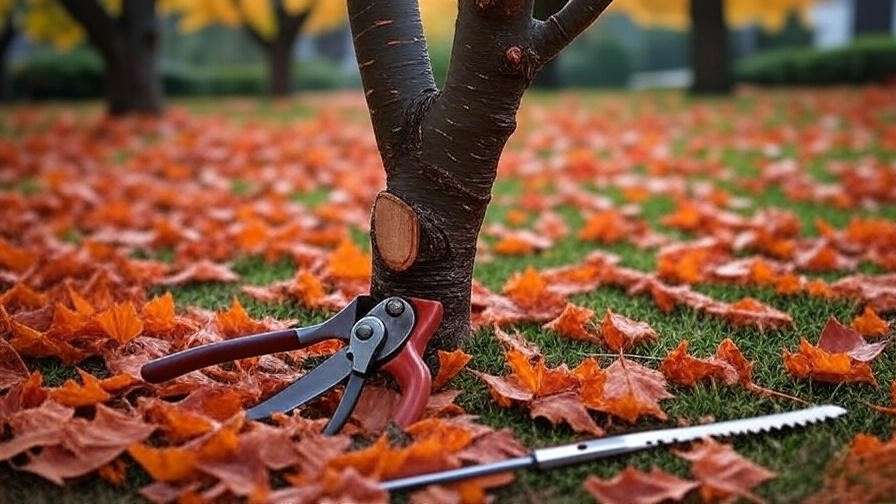
When and How to Prune
Prune in late fall, after leaf drop but before heavy snow sets in. This timing minimizes stress and allows wounds to begin healing before winter dormancy. Follow these steps:
- Remove Weak Branches: Cut away dead, damaged, or weak branches that could collapse under snow.
- Thin the Canopy: Remove crowded branches to improve air circulation and reduce snow load.
- Cut at Proper Angles: Use clean, angled cuts just outside the branch collar to promote healing.
- Avoid Over-Pruning: Remove no more than 25% of the canopy to maintain tree health.
Visual Suggestion: Include a diagram in the final article showing proper pruning cuts for cherry trees.
Expert Insight: “A balanced canopy is like an insurance policy against winter storms,” says ISA-certified arborist Mark Thompson. “Focus on creating an open structure to let snow pass through.” ✂️
Tip 3: Install Physical Supports for Branches 🛠️
Types of Supports
For mature or heavily laden cherry trees, physical supports can prevent branch breakage. Options include:
- Wooden Stakes: Sturdy and affordable, ideal for supporting individual branches.
- Metal Braces: Durable for larger trees but more expensive.
- Props: Adjustable poles placed under heavy branches to bear snow weight.
Each has trade-offs—wooden stakes are budget-friendly but may rot over time, while metal braces offer longevity but require careful installation to avoid tree damage. 🪚
Installation Tips
To install supports:
- Choose Strong Materials: Select stakes or props rated for your tree’s size and expected snow load.
- Position Carefully: Place supports under major branches, ensuring they’re anchored firmly in the ground.
- Use Soft Ties: Secure branches with tree straps or soft rope to prevent girdling.
- Check Stability: Test supports before storms to ensure they hold under pressure.
Safety Note: Never use tight wires or ties that could cut into bark, as this can lead to disease or pest issues.
Example: In upstate New York, a small orchard owner used adjustable metal props to support 10-year-old Montmorency cherry trees during a 2023 ice storm. All trees survived with minimal damage, saving thousands in replacement costs. 🏗️
Tip 4: Wrap Trees to Prevent Ice Damage 🧣
Why Wrapping Helps
Wrapping cherry trees with burlap or commercial tree wraps protects against ice buildup and sunscald—a condition where frozen bark thaws too quickly in winter sun, causing cracks. Young trees, with thinner bark, are especially vulnerable. Wrapping also insulates trunks, reducing stress from temperature swings. The Cornell Cooperative Extension notes that wrapping can reduce winter injury by up to 40% in fruit trees. 🌬️
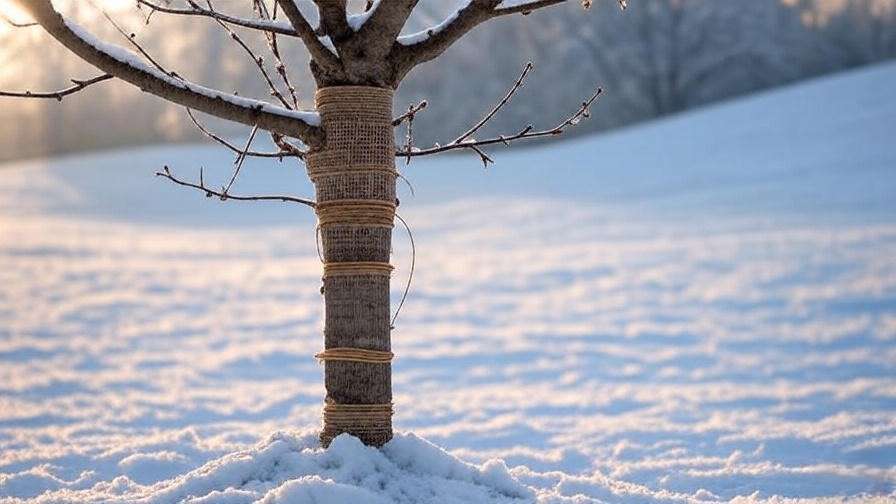
How to Wrap Properly
Follow these steps to wrap your cherry tree:
- Choose Breathable Material: Use burlap, tree wrap, or corrugated cardboard to allow air circulation.
- Start at the Base: Begin wrapping at the soil line, overlapping as you move upward.
- Cover Lower Branches: For young trees, wrap the lower branches to protect against ice.
- Secure Loosely: Use twine to hold the wrap in place without constricting the tree.
- Remove in Spring: Unwrap once the risk of frost passes to prevent moisture buildup.
Expert Tip: “Breathable wraps are key to preventing fungal growth,” advises Dr. Carter. “Check wraps monthly to ensure they’re not too tight or waterlogged.” 🧶
Tip 5: Shake Off Snow Regularly ❄️
Safe Snow Removal Techniques
Heavy, wet snow can accumulate quickly, bending or breaking cherry tree branches. Gently shaking off snow reduces this risk. Use a soft-bristled broom or a long pole to lightly tap branches, allowing snow to fall without damaging the tree. Avoid using sharp tools or excessive force, which can cause bark tears or branch splits. The Penn State Extension recommends checking trees after every significant snowfall, especially wet snow, which can weigh up to 20 pounds per cubic foot. 🧹
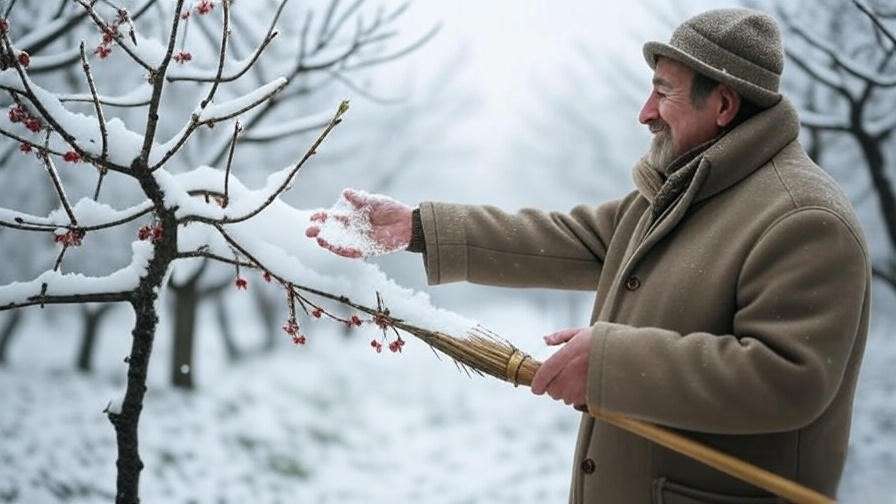
Timing Matters
Monitor weather forecasts and act promptly after snowfalls. Wet snow, common in early or late winter, is heavier and more damaging than dry, powdery snow. If temperatures drop below freezing, wait until a slight thaw to avoid brittle branches snapping. Regular checks—ideally every 1–2 days during stormy periods—can make all the difference.
Real-World Example: Jane, a Michigan gardener, saved her young cherry trees by gently shaking snow off branches after a 2024 blizzard. Her trees bloomed beautifully the following spring, while her neighbor’s unprotected trees suffered heavy losses. ❄️
Tip 6: Mulch and Insulate the Root Zone 🌿
Protecting Roots from Freezing
The roots of cherry trees are just as vulnerable to winter’s extremes as their branches. Heavy snowfall and ice can cause soil temperature fluctuations, leading to root damage or desiccation. Applying a layer of organic mulch around the base of your cherry tree insulates the root zone, maintaining stable soil temperatures and protecting against freeze-thaw cycles. According to the University of Minnesota Extension, a 2–4 inch layer of mulch can reduce root zone temperature swings by up to 10°F, significantly boosting tree resilience. Recommended materials include wood chips, straw, or shredded bark, which also enrich the soil as they decompose. 🌱

Avoiding Common Mistakes
Mulching may seem straightforward, but common errors can harm your tree. Avoid “volcano mulching”—piling mulch against the trunk—which traps moisture and invites rot or pests. Instead, create a donut-shaped mulch ring, keeping the area within 2 inches of the trunk clear. Spread mulch 2–4 inches deep over the root zone, extending to the drip line (the outer edge of the canopy). Check mulch levels mid-winter, as snow or wind can displace it, and refresh as needed. The Michigan State University Extension warns that improper mulching can reduce tree vigor by up to 15% over time. 🌳
Expert Insight: “Mulch is like a cozy blanket for your tree’s roots,” says horticulturist Dr. Emily Carter. “Get the depth and placement right, and you’ll give your cherry tree a fighting chance against winter stress.” 🌿
Tip 7: Monitor and Maintain Post-Storm 🕵️♂️
Assessing Damage After Snow or Ice
After a heavy snow or ice storm, inspect your cherry trees promptly to assess damage. Look for:
- Cracks or Splits: Check the trunk and major branches for fissures, which can indicate structural weakness.
- Broken Branches: Identify snapped or hanging branches that need removal.
- Leaning or Uprooting: Ensure the tree’s base is stable, as heavy snow can shift roots in young trees.
- Bark Damage: Look for peeling or cracked bark, which may signal sunscald or ice injury.
The ISA recommends documenting damage with photos and consulting a certified arborist for severe issues, such as large trunk splits. Early assessment prevents further deterioration, especially if fungal pathogens exploit wounds. 📸
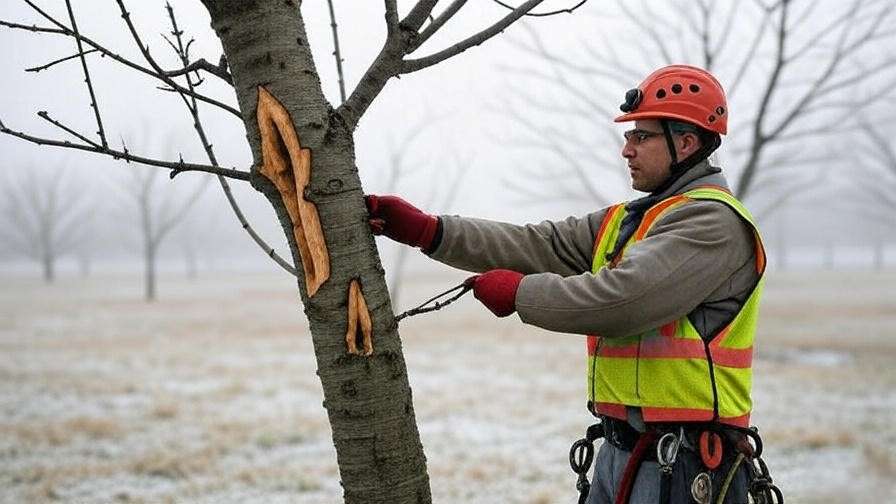
Recovery Tips
If damage occurs, act quickly to aid recovery:
- Prune Damaged Branches: Use clean, sharp tools to remove broken branches, cutting back to healthy wood. Follow the pruning guidelines from Tip 2.
- Apply Wound Treatments (Sparingly): For large cuts, consider a light application of tree wound sealant, though the ISA notes natural healing is often sufficient.
- Fertilize in Spring: Once the growing season begins, apply a balanced fertilizer (e.g., 10-10-10) to support recovery, following extension service guidelines.
- Monitor for Pests: Damaged trees are more susceptible to pests like borers; inspect regularly and consider preventive treatments.
Case Study: In 2022, a Wisconsin gardener noticed minor branch splits on their Montmorency cherry tree after an ice storm. By promptly pruning damaged areas and applying mulch, they nursed the tree back to full health, yielding a record harvest the following year. 🌸
Additional Winter Care Tips for Cherry Trees 🌨️
Watering Before Winter
Proper hydration before winter is critical to prevent desiccation, where trees lose moisture faster than they can absorb it. In late fall, give your cherry trees a deep watering—about 10 gallons per inch of trunk diameter—especially if autumn has been dry. The Penn State Extension notes that well-hydrated trees are 25% less likely to suffer winter injury. Stop watering once the ground freezes to avoid ice formation around roots. 💧
Pest and Disease Prevention
Snow and ice can create conditions for fungal diseases, such as black knot or cytospora canker, which thrive in moist, damaged wood. Before winter, inspect trees for signs of disease (e.g., blackened growths or oozing sap) and remove affected areas. Consider applying a dormant fungicide spray, as recommended by your local extension service, to prevent outbreaks. Regular monitoring in spring can catch issues early, ensuring healthy blooms. 🐞
Long-Term Planning
For ongoing protection, consider structural solutions like windbreaks or snow fences. Planting evergreen shrubs or installing wooden barriers upwind of your cherry trees can reduce snow accumulation by up to 30%, according to the USDA. These measures also shield trees from drying winter winds, preserving moisture in branches and buds. Plan these additions in late summer for maximum effectiveness. 🌬️
Frequently Asked Questions (FAQs) ❓
Q1: Can cherry trees survive heavy snow without intervention?
While some hardy varieties like North Star may endure mild snowfalls, unprotected trees face significant risks. The USDA reports that up to 30% of unprotected cherry trees suffer branch loss in severe storms. Proactive measures like pruning and wrapping greatly improve survival rates. 🌳
Q2: How do I know if my cherry tree is damaged after a storm?
Look for cracks in the trunk, broken or hanging branches, leaning, or peeled bark. Minor damage can be pruned, but consult an arborist for major splits or uprooting. Documenting damage with photos aids in assessment. 📷
Q3: Are there cherry tree varieties that don’t need winter protection?
No variety is entirely immune, but cold-hardy ones like Montmorency or Meteor require less intervention in Zones 4–7. Even these benefit from mulching and pruning to maximize resilience. 🌱
Q4: What should I do if ice has already formed on my cherry tree?
Avoid removing ice manually, as this can break branches. Wait for a natural thaw, then assess and prune any damage. Wrapping the tree post-thaw can prevent further injury. ❄️
Conclusion 🌸
Protecting your cherry trees from heavy snowfall and ice is an investment in their beauty and productivity. By choosing cold-hardy varieties, pruning strategically, installing supports, wrapping trunks, shaking off snow, mulching roots, and monitoring post-storm, you can ensure your trees thrive through winter’s challenges. These seven tips, grounded in expert advice and research from sources like the USDA and university extensions, empower you to safeguard your garden’s treasures. Start preparing now—inspect your trees, gather supplies, and share your winter care tips in the comments below. With proper care, your cherry trees will reward you with stunning spring blossoms and juicy summer fruit. Happy gardening! 🍒✨

